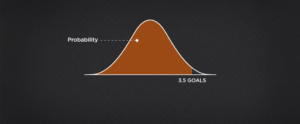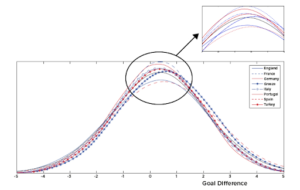Betting handicap by using Standard Deviation
By knowing how bettors use standard deviation for handicap betting, you can more reliably gage the likelihood of a team that can cover the spread, which can turn into more revenue.

Using the top soccer leagues in Europe as an example
We use the 2013/14 season data below for the top divisions in Germany, France, England, Greece, Turkey, Portugal, Italy, and Spain.
The table shows the discrepancies in goals-scored between home and away goals-over the last season. A positive difference in the goal means the home team has scored, while a negative difference in the goal signifies a win for the away team.

The table shows some relations:
- Biggest home wing (goals): 5 ~ 7
- Biggest away win (goals): 5
- Most apparent goal difference: Draw
- Home team score > Away team score
However, there are some variances between leagues as bettors would expect. The Greek Superleague has a higher average goal differential, while the most common goal differential is to see the home team win by 1 goal.
In correlation, the Portuguese Primeira Liga has the lowest average goal differential, while France’s Ligue 1 and Spain’s La Liga have the same deviation at different extremes.
The graph below illustrates how goal differences can be beneficial in understanding these subtle variations if modeled using a normal distribution.

By looking at the betting graphs, the lower the standard deviation (France and Portugal), the narrower the curve should be noted. For the Greek Superleague, the midpoint of the graph is higher than any other league.
How does the Standard Deviation effect handicaps?
We can apply the data that we had to relate to football handicaps. For example, you can measure the likelihood of a team winning by several goals by inputting the above data in the form below, something handy for handicap bets.

The odds shown in the above table illustrate the probability of a home win and the home team winning in the previously listed leagues by more than 2.5 goals.
From the data, we can see that in France on average home teams score more than in Germany (0.3763 vs. 0.3743), but they are less likely to win and less capable of winning by a huge margin. What’s that for?
It’s due because of a lower standard deviation (1.5975 vs. 1.7757), mean goal discrepancies are less likely to be at the opposite end of the scale in France.
The leagues, which is a home team is more apt to win than draw or lose are the Greek and Spanish – it is not that surprising considering that they have the most considerable average difference in goal.
Given the higher probability of home Greek teams winning, Spanish teams are more likely to win by a more significant margin. Why? Spain’s higher standard deviation suggests there’s a greater chance of substantial goal discrepancies in La Liga. Bettors will begin to see a trend forming here.
Similarly, home teams in England win less frequently than in Turkey, but a higher distribution of goals means betters can see more value betting on the home team to cover the disadvantage than they do in Turkey.
Sports Bettors should remember that in some competitions, the higher standard deviation will direct to a more significant proportion of big win & loss, something important for handicap bettors.
This article discussed the use of the standard distribution from a particular perspective and explains how to bets on handicap by using Standard Deviation. Nonetheless, the assumptions set out in other studies still apply: the delivery must generally be a curved bell-shaped and not skewed on either side. In the future, we will be exploring in more depth how to check this claim.





